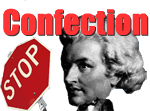Assignment Page
 In this assignment, you'll use Photoshop to create an image that visually summarizes and analyzes a complex idea, theory, or extended narrative in a single eye span. Edward Tufte's Chapter 7 from Visual Explanations discusses the techniques and history this genre of visual rhetoric, calling it a visual confection.
In this assignment, you'll use Photoshop to create an image that visually summarizes and analyzes a complex idea, theory, or extended narrative in a single eye span. Edward Tufte's Chapter 7 from Visual Explanations discusses the techniques and history this genre of visual rhetoric, calling it a visual confection.
A classic example of a confection used to visually summarize a complex set of ideas is the Food Pyramid. Imagine it appearing in a poster on the wall of a school cafeteria.
Audience
You can assume the viewer of your confection is acquainted with the concept being visualized, having read the book or article or having taken the course where the concept is from. As Tufte observes, visual confections are based on ideas that have been elaborated in writing.
The design and details of your confection will serve to help the viewer to better remember the concept, and to understand it more fully. Imagine students of the concept taping your poster above their desks, or propping your postcard against a coffee cup while studying, to remind and inspire them.
A Concept Visualized
Your confection should bring together words and images to visualize a complex set of ideas: an argument, a multifaceted definition, a set of detailed choices, the cause-and-effect relations in a process or story, and so on. This concept could be drawn from your major, a book, magazine article, or online analysis. An "analytical concept" is
an abstract idea or general phenomenon broken down into its component parts that are elaborated in their dynamic relations for the purpose of explanation or memory.
It would be best to choose a concept that you personally know and find interesting and useful. A novel, movie, or television series could also serve as a "concept" if your confection is visualizing an interpretation of that narrative's meaning, rather than just the plot. An musical album could be a concept if the songs (and their sequencing) suggest larger, interrelated ideas that constitute a unified whole.
It is not only permitted, but recommended, that you use someone's else's published analysis or interpretation for your visualization.
Genre
Conceive and design the image to work as a particular visual genre and for a particular audience: that is as a poster (popular or academic), as a postcard, bookmark, frontispiece or poster-insert for a book, illustration for a magazine article, etc.
Confection vs. Collage
Tufte advises us to avoid creating a simple collage, which combines images in suggestive but diffusely intended ways. Instead, aim at producing what Tufte calls a "miniature theatre of information" that makes "reading and seeing and thinking identical" (138, 151).
Image(s) Should Dominate
Your confection may include some supplemental text, but the explanatory weight should be carried mostly by the confection itself, which should be one (perhaps multifaceted) image. See the many examples in Tufte's Chapter 7.
Commentary
You will write a commentary for this project to be turned in the class meeting after you have submitted the project. In addition to following the general guidelines for excellent commentaries, the Confection Commentary should
- usefully quote and cite Tufte at least twice
- compare or contrast your confection to some aspect of at least three other confections, either from the Tufte book or from the examples in class.
Words that Suggest a "Concept"
Examples of "concepts" can sometimes be identified by certain key kinds of words. See the bolded terms in the examples below:
- Greg Ulmer's Theory of the Manifesto,
- Hayden White's "Narrative of Discovery,"
- Winifred Gallagher's explanation (following Grant Hildebrand) of why some buildings appeal more to us than others.
- Anthony Easthope's distinction between Iconic and Elaborated Discourses.
- Max Weber's The Protestant Ethic and the Spirit of Capitalism
- Richard Slotkin's Regeneration Through Violence: The Mythology of the American Frontier, 1600-1860
- Elizabeth Kubler Ross's Stages of Grief
- Evolution/Creationism Debate
- Beethoven and Romanticism
- The Useful Milkweed Plant
- Radiohead's album cover for Hail to the Thief (confections or collage?)
- more about Burton's Anatomy of Melancholy
- Confection: Getting Started